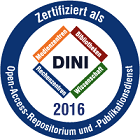Korte, Christoph Anton Conrad: Phenotypic evaluation of wild Silphium perfoliatum L. accessions to create a breeding basis for material use. - Bonn, 2024. - Dissertation, Rheinische Friedrich-Wilhelms-Universität Bonn.
Online-Ausgabe in bonndoc: https://nbn-resolving.org/urn:nbn:de:hbz:5-79657
Online-Ausgabe in bonndoc: https://nbn-resolving.org/urn:nbn:de:hbz:5-79657
@phdthesis{handle:20.500.11811/12530,
urn: https://nbn-resolving.org/urn:nbn:de:hbz:5-79657,
doi: https://doi.org/10.48565/bonndoc-420,
author = {{Christoph Anton Conrad Korte}},
title = {Phenotypic evaluation of wild Silphium perfoliatum L. accessions to create a breeding basis for material use},
school = {Rheinische Friedrich-Wilhelms-Universität Bonn},
year = 2024,
month = nov,
note = {Cup plant (Silphium perfoliatum L.) is a promising herbaceous perennial for biomass production. In Germany, S. perfoliatum is mainly grown as a substrate for biogas reactors. Aside from the plant being useful for generating energy, interest in material use of the plant is increasing, especially regarding harvesting biomass at a late stage. Recent studies have shown that harvesting perennials during the growing season lowers their nutrient use efficiencies. The past few years have seen optimization of cup plant cultivation, such as crop establishment by sowing and yield improvements through crop management (plant density, fertilization level and plant protection), with the aim of making cup plant suitable for practical use and maximizing yield and quality of biomass. However, the biomass production of cup plant still cannot completely keep up with that of its competitors. There are several publications declaring a need for breeding improvements of S. perfoliatum. Due to the limited variation in the available plant material only a few studies mention actual breeding intentions. To increase the available variations in S. perfoliatum, seeds of wild plants were collected from its natural habitat. This collection and the material use of late harvested Silphium biomass are the foundation of this thesis. The new Silphium collection expands the variation of plant material available in Europe in nearly all phenotype plant traits. In most cases this expansion is directed towards more and less trait expression. The recorded plant traits include dry matter yields, yield- and quality-determining traits (plant height, shoot width, shoot number, flowering progress, cellulose and lignin content as well as lodging), Sclerotinia susceptibility, seed yield traits (seed number per flower head and seed weight), seed geometric traits (achene area, achene length, achene width and achene eccentricity) and seed oil traits (oil content, portions of the fatty acids 14:0, 16:0, 18:0, 18:1 and 18:2). In addition, the collection of wild Silphium accessions revealed previously unknown differences in cup formation, which were investigated too. In terms of biomass production, several wild accessions already outperform the available plant material in Europe. Through selection, further yield improvements are expected. Long-term breeding goals may include increased quality of biomass, pathogen resistances, achene size and cup formation (impact of cup formation on the crop still needs to be determined). Moreover, a BBCH-scale was generated, allowing for the detection of developmental stages as a plant trait and to set standards in plant breeding and crop management. Furthermore, new material use of senescent harvested biomass and of seed oil have been investigated, such as using milled cup plant biomass as an additive for paper production and as a substitute in bonded leveling compound. Both applications offer a sustainable alternative to conventional methods. Silphium oil needs modifications to fit material purposes, but these modifications should be accessible through plant breeding.},
url = {https://hdl.handle.net/20.500.11811/12530}
}
urn: https://nbn-resolving.org/urn:nbn:de:hbz:5-79657,
doi: https://doi.org/10.48565/bonndoc-420,
author = {{Christoph Anton Conrad Korte}},
title = {Phenotypic evaluation of wild Silphium perfoliatum L. accessions to create a breeding basis for material use},
school = {Rheinische Friedrich-Wilhelms-Universität Bonn},
year = 2024,
month = nov,
note = {Cup plant (Silphium perfoliatum L.) is a promising herbaceous perennial for biomass production. In Germany, S. perfoliatum is mainly grown as a substrate for biogas reactors. Aside from the plant being useful for generating energy, interest in material use of the plant is increasing, especially regarding harvesting biomass at a late stage. Recent studies have shown that harvesting perennials during the growing season lowers their nutrient use efficiencies. The past few years have seen optimization of cup plant cultivation, such as crop establishment by sowing and yield improvements through crop management (plant density, fertilization level and plant protection), with the aim of making cup plant suitable for practical use and maximizing yield and quality of biomass. However, the biomass production of cup plant still cannot completely keep up with that of its competitors. There are several publications declaring a need for breeding improvements of S. perfoliatum. Due to the limited variation in the available plant material only a few studies mention actual breeding intentions. To increase the available variations in S. perfoliatum, seeds of wild plants were collected from its natural habitat. This collection and the material use of late harvested Silphium biomass are the foundation of this thesis. The new Silphium collection expands the variation of plant material available in Europe in nearly all phenotype plant traits. In most cases this expansion is directed towards more and less trait expression. The recorded plant traits include dry matter yields, yield- and quality-determining traits (plant height, shoot width, shoot number, flowering progress, cellulose and lignin content as well as lodging), Sclerotinia susceptibility, seed yield traits (seed number per flower head and seed weight), seed geometric traits (achene area, achene length, achene width and achene eccentricity) and seed oil traits (oil content, portions of the fatty acids 14:0, 16:0, 18:0, 18:1 and 18:2). In addition, the collection of wild Silphium accessions revealed previously unknown differences in cup formation, which were investigated too. In terms of biomass production, several wild accessions already outperform the available plant material in Europe. Through selection, further yield improvements are expected. Long-term breeding goals may include increased quality of biomass, pathogen resistances, achene size and cup formation (impact of cup formation on the crop still needs to be determined). Moreover, a BBCH-scale was generated, allowing for the detection of developmental stages as a plant trait and to set standards in plant breeding and crop management. Furthermore, new material use of senescent harvested biomass and of seed oil have been investigated, such as using milled cup plant biomass as an additive for paper production and as a substitute in bonded leveling compound. Both applications offer a sustainable alternative to conventional methods. Silphium oil needs modifications to fit material purposes, but these modifications should be accessible through plant breeding.},
url = {https://hdl.handle.net/20.500.11811/12530}
}






